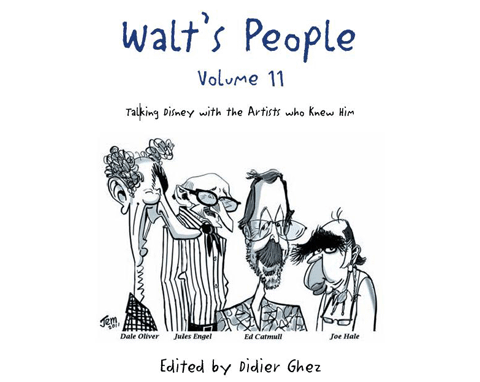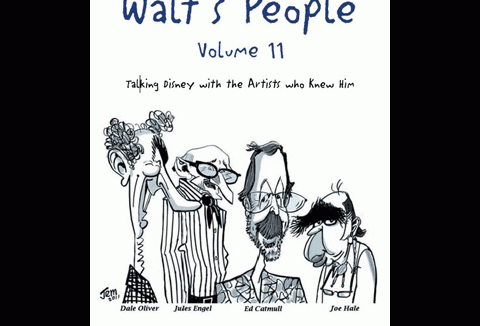

Exclusive Excerpt from “Walt’s People”

Over the last seven years, with quiet persistence and unwavering dedication, French animation historian Didier Ghez has been publishing one of the most important animation history documents of our time. His book series, Walt’s People: Talking Disney With The Artists Who Knew Him, is an incredible accomplishment that casts new light onto the operation of the Walt-era Disney Studios. Each edition of this ever-growing interview anthology series reprints rarely seen and unpublished interviews with Disney artists, both famous and unknown.
Didier’s newest volume, the eleventh in the series, is also the largest to date, weighing in at over 600 pages. The historians who have contributed interviews are a who’s who of Disney research royalty. The volume is expansive and extends to a handful of contemporary figures who didn’t personally know Walt (Ed Catmull, Brad Bird, Glen Keane), but who have absorbed the Disney tradition into their work.
In fact, the sheer scale and scope of this volume guarantees something for everybody. The interview subjects are Ray Aragon, Frank Armitage, Brad Bird, Carl Bongirno, Roger Broggie, George Bruns, Ed Catmull, Don R. Christensen, Andreas Deja, Jules Engel, Joe Hale, John Hench, Mark Henn, John Hubley, Glen Keane, Ted Kierscey, Ward Kimball, I. Klein, Mike Lah, Eric Larson, Ed Love, Daniel MacManus, Tom Nabbe, Carl Nater, Dale Oliver, Walt Pfeiffer, Jacques Rupp, David Snyder, Iwao Takamoto, Shirley Temple, Frank Thomas, Ruthie Tompson, and Richard Williams.
Walt’s People #11 is available for $25 on Amazon and you’d be wise to add the rest of the series
to your library as well. Didier has provided us some excerpts from the new book, offering a glimpse of the hundreds of stories that can be found in the book. Read them after the jump.
Ruthie Tompson by Didier Ghez (Dec. 21, 2007)
DG: There is a famous anecdote about Snow White that the girls who were painting Snow White would apply real makeup on her cheeks.
RT: Oh! That’s right, they did. We had one girl, her name was Helen Ogger… They all tried it, and she was the only one that was really successful at it, so she got to put the blush. Before she came to work at Disney, I understand that she was a cartoonist, like cartoon strips and things like that, in the newspaper. We had quite a few talented girls, but they were relegated to the Inking Department. Girls didn’t animate at the time. It was all a man’s game.
John Hubley by John Culhane (c. 1973)
JC: Do you remember when Frank Lloyd Wright came to the Studio? Did you see that film he had with him?
JH: Czar Durandei. It had a big influence on us guys who later became UPA. It was Ivan Ivanov-Vano’s first film, one of his early films. He was a young rebel in those days. He made this very avant-garde kind of thing, highly designed. It was in the, I suppose you can call it expressionist style, the kind of style from the Twenties and Thirties. It was so modern and fresh and violated so many of the totems. Shostakovich score, too, that was modern, exciting. It was a two-reeler. There was a marvelous eating scene, a big banquet, a long pan and all kinds of different types of faces, all eating in different ways. That was so funny. There was a minimum amount of animation.
You remember John Rose? He was a P.R. man and he was also working in and out of story meetings, but essentially his job was cultural relations. He’s the guy who, if somebody visited, he would show them through. So he had heard about this film that Frank Lloyd Wright got. He’d read or heard somewhere that the Russian government had given him a print of this thing when he was a guest over there. Wright went over there in the early Thirties. And so [Rose] wrote him and said, “We at the Disney Studio have heard about this and are very much interested if you would see your way clear to lending us the print.”
So next thing he knows he gets a telephone call, “This is Frank Lloyd Wright, Mr. Rose. I’ve just arrived in Los Angeles. I have the print with me. I would like to come out and show it to Mr. Disney. I’ll be out this afternoon.”
Now the rumors were around that Disney was going to build a new studio. Wright got wind of that. It made a lot of sense to him that he should design it. Rose was frantic. He went to see Walt’s secretary. She said, “He is in a big meeting and nobody goes in there.” But she let him go in there and Walt is in the middle of a story conference, which is sacrosanct. [Rose] kneels down next to Walt’s chair and says, “We’re gonna get a visitor coming this afternoon. Frank Lloyd Wright is coming up.” And Disney says, “Jesus Christ, who’s Frank Lloyd Wright?” So he had to explain who Frank Lloyd Wright was and Disney says, “Oh, yeah!”
So [Rose] set it up. [Wright] came out, the big man himself, white hair, and Disney said hello to him. And they had this projection with all the story guys and the top brass. They ran Snow White footage for him, pencil-test stuff. They had a reel of Fantasia, too, and they had Sorcerer’s Apprentice in pencil test. And he went, “Well, that’s magnificent. That is exactly the way you should do it”. And Disney said, “You have a film to show us?” “Oh yes, yes.” “Put the film on.” The lights came up and nobody said a word. Frank said, “Walt Disney, you too can be a prophet!” And Disney said, “What, Jesus Christ, you want me to make films like that?!” [Laughs]
Ray Aragon by Didier Ghez (Feb. 23 and March 5, 2009)
DG: Did you interact a lot with Walt Peregoy?
RA: We were close friends. I can tell you [a story] right now. I can tell you for sure. I was there and I saw it. We did the drawing on paper and that drawing was transferred to the cel, as you know, by Xerox. We had to layout in line drawing on the cel. The idea was to paint on a board the color. Then put the layout drawing, which was on cel, over the painted background, which was on an illustration board. We couldn’t find the answer. The answer that we got at first looked like a comic book. It looked like a cheap comic book. Then the Background Department tried this and they tried that. It didn’t work. This went on for some time. Then finally Walt Peregoy took the painting style of Raoul Dufy. Walt Peregoy took the style where you paint beyond the line. Where you just ignore the lines and paint over and beyond. It looks like nothing. But when you put the line on the thing, there it is.
So what Walt did was he took an illustration board and he made color swatches this way and that way and every which way. But of course using the line drawing as the guide, but never going right up to the line of the drawing. Sometimes overlapping the line. If you look at Walt Peregoy’s color on the illustration board, you saw this crazy stuff that almost makes sense. But it didn’t really make sense. But when you put the cel with the line drawing, it was beautiful. Walt Peregoy was the man who discovered and styled the background technique for One Hundred and One Dalmatians. That I know because I saw it. I saw it happen right before my eyes. He solved it.
Ed Catmull by Didier Ghez (April 20, 2011)
DG: If I move up quite a few years, in 1972 you are studying with Professor Sutherland. And I think that is when you really have your first contact with Disney. Right?
EC: Yes, Ivan [Sutherland] wanted to send a student to go to Disney and then have an animator from Disney come to Utah. I was sent as the student because of my interest in animation. I went out to Burbank and met with Bob Gibeaut, who was Head of the Studio. I remember they had to clear the Studio that day because there was a bomb threat.
I also met Frank Thomas in his office. I remember seeing his old typewriter which I thought was there as an antique, but it was actually the typewriter that he still used. This, of course, was in the Animation building.
It turns out the Studio was not terribly interested in making the exchange, because they didn’t see any relevance of computer animation to them. What they were really interested in was hiring me at WED (now Walt Disney Imagineering).
